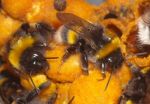(Press-News.org) A study co-authored by a University of Guelph scientist that involved fitting bumblebees with tiny radio frequency tags shows long-term exposure to a neonicotinoid pesticide hampers bees' ability to forage for pollen.
The research by Nigel Raine, a professor in Guelph's School of Environmental Sciences, and Richard Gill of Imperial College London was published July 9 in the British Ecological Society's journal Functional Ecology.
The study shows how long-term pesticide exposure affects individual bees' day-to-day behaviour, including pollen collection and which flowers worker bees chose to visit.
"Bees have to learn many things about their environment, including how to collect pollen from flowers," said Raine, who holds the Rebanks Family Chair in Pollinator Conservation, a Canadian first.
"Exposure to this neonicotinoid pesticide seems to prevent bees from being able to learn these essential skills."
The researchers monitored bee activity using radio frequency identification (RFID) tags similar to those used by courier firms to track parcels. They tracked when individual bees left and returned to the colony, how much pollen they collected and from which flowers.
Bees from untreated colonies got better at collecting pollen as they learned to forage. But bees exposed to neonicotinoid insecticides became less successful over time at collecting pollen.
Neonicotinoid-treated colonies even sent out more foragers to try to compensate for lack of pollen from individual bees.
Besides collecting less pollen, said Raine, "the flower preferences of neonicotinoid-exposed bees were different to those of foraging bees from untreated colonies."
Raine and Gill studied the effects of two pesticides – imidacloprid, one of three neonicotinoid pesticides currently banned for use on crops attractive to bees by the European Commission, and pyrethroid (lambda cyhalothrin) – used alone or together, on the behaviour of individual bumblebees from 40 colonies over four weeks.
"Although pesticide exposure has been implicated as a possible cause for bee decline, until now we had limited understanding of the risk these chemicals pose, especially how it affects natural foraging behaviour," Raine said.
Neonicotinoids make up about 30 per cent of the global pesticide market. Plants grown from neonicotinoid-treated seed have the pesticide in all their tissues, including the nectar and pollen.
"If pesticides are affecting the normal behaviour of individual bees, this could have serious knock-on consequences for the growth and survival of colonies," explained Raine.
The researchers suggest reform of pesticide regulations, including adding bumblebees and solitary bees to risk assessments that currently cover only honeybees.
"Bumblebees may be much more sensitive to pesticide impacts as their colonies contain a few hundred workers at most, compared to tens of thousands in a honeybee colony," Raine said.
INFORMATION: END
Bee foraging chronically impaired by pesticide exposure: Study
2014-07-09
ELSE PRESS RELEASES FROM THIS DATE:
Adults with special needs see gains, challenges with long term oral care
2014-07-09
BOSTON (July 9, 2014) — A retrospective study conducted by researchers at Tufts University School of Dental Medicine and colleagues reports that among adults with intellectual and developmental disabilities, the likelihood of having cavities decreased as the number of years receiving dental care increased. The findings, published in the July/August issue of Special Care in Dentistry, may help improve interventions designed to address the oral health of individuals in this population.
The researchers reviewed the dental records of 107 patients at one of the eight clinics ...
Most prescription labels fail to meet guidelines, risking dosage errors
2014-07-09
Small print and poor printing on prescription labels handed out by pharmacists may be misread and may lead to errors in taking medication, according to new research by the University of Waterloo and CNIB (Canadian National Institute for the Blind).
The study, published recently in the Canadian Pharmacists Journal, found that labels on prescription medications dispensed by pharmacies do not consistently follow professionally recommended guidelines for legibility.
By simply following recommended guidelines for font size, use of bolding, justification, sentence case and ...
Penn study finds living kidney donation does not increase risk of death or heart disease for older
2014-07-09
PHILADELPHIA – Previous studies linking older age with kidney and heart disease have raised concerns about the safety of living kidney donation among older adults. However, in the first study to look closely at this issue, researchers at the Perelman School of Medicine at the University of Pennsylvania report that older kidney donors (55 years and above) enjoy similar life expectancy and cardiovascular health as very healthy older people who did not donate their kidneys. In light of the ever increasing organ transplant waitlists, the authors of the study hope the results ...
Projecting a 3-dimensional future
2014-07-09
Since the 1960s, theatergoers have shelled out for crude 3-D glasses, polarized glasses, and shutter glasses to enhance their viewing experience. These basic devices, used to trick the brain into perceiving an artificial three-dimensional reality, may soon be rendered obsolete with the introduction of new holography technology developed by Tel Aviv University researchers.
TAU doctoral students Yuval Yifat, Michal Eitan, and Zeev Iluz have developed highly efficient holography based on nanoantennas that could be used for security as well as medical and recreational purposes. ...
Shark teeth analysis provides detailed new look at Arctic climate change
2014-07-09
A new study shows that some shark species may be able to cope with the rising salinity of Arctic waters that may come with rising temperatures.
The Arctic today is best known for its tundra and polar bear population, but it wasn't always like that. Roughly 53 to 38 million years ago during what is known as the Eocene epoch, the Arctic was more similar to a huge temperate forest with brackish water, home to a variety of animal life, including ancestors of tapirs, hippo-like creatures, crocodiles and giant tortoises. Much of what is known about the region during this period ...
Making a more healthful, low-fat hot dog without giving up texture
2014-07-09
With grilling season upon us, many backyard cooks are turning to more healthful alternatives to their savored but fatty hot dogs. But low fat can sometimes mean low satisfaction. Now researchers are reporting new progress toward addressing the texture problem in low-fat wieners that are made with olive oil rather than pork fat. Their study was published in ACS' Journal of Agricultural and Food Chemistry.
Ana M. Herrero and colleagues note that hot-dog consumers have come to expect just the right amount of chewiness and springiness, among other things, from their beloved ...
Tiny DNA pyramids enter bacteria easily -- and deliver a deadly payload
2014-07-09
Bacterial infections usually announce themselves with pain and fever but often can be defeated with antibiotics — and then there are those that are sneaky and hard to beat. Now, scientists have built a new weapon against such pathogens in the form of tiny DNA pyramids. Published in the journal ACS Applied Materials & Interfaces, their study found the nanopyramids can flag bacteria and kill more of them than medicine alone.
David Leong, Jianping Xie and colleagues note that some infectious pathogens can lie in wait, undetectable in the human body or in places that antibiotics ...
My brother's keeper
2014-07-09
This news release is available in French.
Montreal, July 9, 2014 — Whether it's how to throw a ball or put together a puzzle, young children learn a lot from their older siblings. While researchers have long known that brothers and sisters teach each other about the world, most of their observations about this have been made in a lab setting.
A new study recently published in the Journal of Cognition and Development by Concordia University education professor Nina Howe takes that investigation a step further by observing how children interact in their natural habitat: ...
What drives a child to abuse alcohol?
2014-07-09
This news release is available in French. By looking at 40 different factors in 14 year old teens, including brain structure and function, personality, life experiences and genetics, researchers can predict with 70% accuracy who will go on to develop binge drinking within the next two years. Impulsivity, hopelessness, sensation-seeking traits, lack of conscientiousness, and other variables such as life events and a family history of drug use contribute to the likelihood of binge drinking. Whether or not the child had had a single drink at age 14 was a particularly ...
One secret of ancient amber revealed
2014-07-09
The warm beauty of amber was captivating and mysterious enough to inspire myths in ancient times, and even today, some of its secrets remain locked inside the fossilized tree resin. But for the first time, scientists have now solved at least one of its puzzles that had perplexed them for decades. Their report on a key aspect of the gemstone's architecture appears in the ACS journal Analytical Chemistry.
Jennifer Poulin and Kate Helwig of the Canadian Conservation Institute point out that much of the amber we see today had its origins millions of years ago, when it exuded ...

